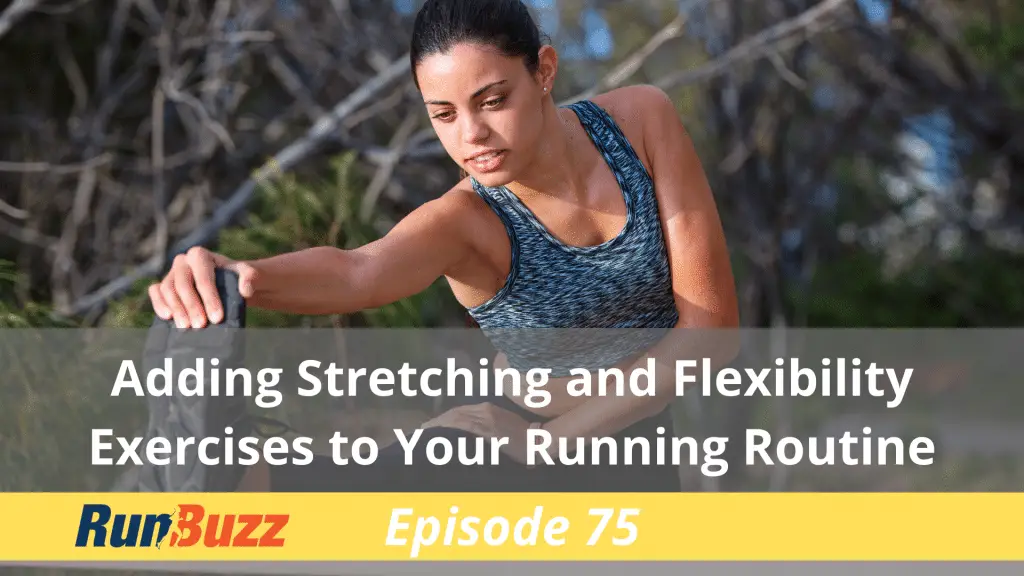<iframe title=”Embed Player” src=”//play.libsyn.com/embed/episode/id/5939968/height/128/theme/modern/size/standard/thumbnail/yes/custom-color/87A93A/time-start/00:00:00/playlist-height/200/direction/backward” height=”128″ width=”100%” scrolling=”no” allowfullscreen=”” webkitallowfullscreen=”true” mozallowfullscreen=”true” oallowfullscreen=”true” msallowfullscreen=”true” style=”border: none;”></iframe>
In this episode, I dig into the topic of Flexibility and Mobility. Do we do it, don’t do it, what should we be doing? I have covered this topic before in bits and pieces over the years and I have mentioned before that prior to a run, we should focus more on warm-up exercises, or dynamic warm-ups and stretches that get our blood flowing and muscles warmed up.
But that does not mean that static stretching and other type of flexibility exercises do not have their place in our day-to-day routine. They do. Flexibility and Mobility play a huge part in our overall fitness and wellness.
“This article contains links to some recommended products. Please note, as an Amazon Associate I may earn from qualifying purchases.”
Show Notes:
The Importance Of Flexibility
As we age, flexibility and mobility will become more and more important to each and every one of us. Those of us in our 30’s, 40’s, and 50’s will see the biggest decline in our flexibility than at any other time in our life. If we do nothing, most of us will have muscles that become tight, are slow to move, and we will feel occasional discomfort as our body ages and starts to resist our movement. I know because when I slack off with stretching, I feel it. After I stretch, get a sports massage and focus on mobility for a period of time, I feel a lot better, younger even.
So in this podcast episode, I dig deeper into the topic than I have in the past. I think when it comes to cross-training we tend to ignore our flexibility or we tend to follow a half-assed approach by doing a few static stretches before or after a run and leave it at that.
As runners, when we do cross-train, we tend to focus more on low impact cardiovascular exercises that supplement our running like riding a bike, going for a swim, using elliptical machines and stair climbers Or focusing on more resistance exercises like strength training. And, all of these are extremely important!
But being flexible ensures you have a full range of motion and that the muscle fascia or other tightness is not limiting your mobility. Fascia makes up as much of 30% of our body’s total muscle mass and accounts for up to 41% of our muscles’ resistance to movement. So, if you ever wonder why those first few miles or kilometers feel sluggish and tight this is why. Things like flexibility exercises, warm-ups, and foam rolling help ensure you maintain your full range of motion and overall mobility.
But here is the problem…. Most of us don’t do it. And those of us who do, probably aren’t doing enough.
When running is our primary sport or fitness activity, running should take up the bulk of your training time, followed then by strength training and flexibility equally.
How Often Should You Do Strength Training and Flexibility as a Runner?
For most recreational runners, strength training up to 2-3 times per week is fine. But when it comes to mobility and flexibility exercises, you will want to do them daily or as often as you can. BOTH strength training and flexibility complement each other and have equal importance. The reason you can (and should) do flexibility more often is that you don’t need as much recovery time and it generally takes more frequent sessions to see results, as you can tighten back up fairly quickly if too much time goes by.
What are the Benefits of Stretching and Flexibility Training for Runners?
Stretching and flexibility exercises help:
- Reduce delayed onset muscle soreness
- Elongate the muscle and improve range of motion and joint mobility
- Encourage faster recovery after exertion
- Increase balance and spatial awareness
- Reduce the overall risk of injury
- Reduce muscle tension and adhesion
- Improve muscle performance and strength
- Enhance muscle coordination and blood circulation
- Increase balance and spatial awareness
- Enhance overall relaxation and sense of wellness
Effectiveness of Stretching Comes Down to Two Major Contributing Factors:
- 1Your genetic predisposition and physical makeup. (You can’t control this)
- 2The quality to which you introduce stretching and flexibility exercise into your daily routine. (You can control this)
Stretching Exercises that Runners Should be Aware of
Ballistic Stretching
Ballistic stretching is stretching that uses a fast bouncing motion to push your body past (or just beyond) its normal range of motion. You do not want to do this type of stretching! Avoid any stretch that includes a bouncing motion. The only reason I am including it is that I see runners doing this on occasion while warming up at races and while it can be beneficial for a small group of athletes in isolated situations, it is not recommended for the average fitness enthusiast as it increases the risk of injury.
Dynamic Stretching / Warm Up
Dynamic stretching employs active movement through a full range of motion to help stretch and prepare muscles and joints for activity. Right before your run or race is the best time to do this as it helps you warm up the muscles and joints, increase blood and oxygen flow and get you ready for your run. Here is a quick video with a few examples of dynamic stretches:
Active Isolated Stretching
Active Isolated Stretching involves extending your muscle to a stretch, holding that position for 2 seconds and then returning to the starting position. The basic idea behind this type of stretch is that it lengthens the muscle by triggering something known as the protective stretch reflex. The protective stretch reflex is a built-in self-protection mechanism that your body will use to protect against stretching too far or too fast and is likened to a reflex movement.
Passive Stretching
Passive Stretching is a type of stretching exercise that uses outside assistance (like another person, immovable object, gravity, bodyweight or stretching device). With Passive Stretching, you use resistance or a stretching device (like a strap, bath towel, or calf stretching block) to maintain pressure as the muscle lengthens. While you do this type of exercise the key is to relax throughout the stretch and just apply gentle pressure.
Static Stretching
Static Stretching is where you hold a stretch in a challenging, but comfortable position, for a specific period of time. The hold phase is usually somewhere between 15 and 90 seconds.
Isometric Static Stretching
Isometric Static Stretching is a stretching exercise that requires zero movement at all. All you do in this type of stretch is tense the muscle that you are targeting. To best visualize this approach is to take your arm like you are showing off your bicep muscle, and then squeeze the bicep muscle until you feel that light burn. Then apply this technique to other muscle groups. This tensing technique activates and engages the muscle.
Reciprocal inhibition
Reciprocal inhibition is a technique that involves stretching a muscle and then actively contracting the opposing muscle to apply pressure and furthering the stretch. Probably the best way I can describe this is one you can try right now. From a sitting position, take one leg and extend it forward with your toes facing up slightly but not enough that your calf muscles are fully engaged. Once you leg is extended, slowly raise it until you feel your hamstrings and upper calf feeling starting to feel the pressure of the stretch. As soon as you do, (and this takes a little bit of mental concentration), squeeze your quad muscle slightly. As you do, you should feel your hamstring and calf muscle feel the additional pressure of a stretch. This is reciprocal inhibition. It is a way of adding or complementing a stretch and is a technique that you can apply to certain situations. For example, for some runners, some muscle groups may not stretch easily or be as noticeable when doing a more formal static stretch. Applying this technique can sometimes engage the muscle better so you can get a good stretch.
Proprioceptive Neuromuscular Facilitation (PNF Stretching)
Whew! What a fancy word! PNF Stretching is a technique of combining multiple techniques together into a more advanced type of flexibility exercise. For example, you can stretch and contract targeted muscles starting with a passive stretch, then apply contraction, then release and do a second, deeper passive release. Think contract/relax, hold/relax. This is an oversimplification but the idea behind this type of stretch.
Myofascial Release
Myofascial Release is often implemented using either foam rolling and/or massage. It usually includes some combination of stretching, compression, direct pressure and other techniques to release restricted areas of fascia, which ideally creates more efficient movement. Foam rollers and other devices are probably the most common ways this is done although a trained massage therapist can use their hands or other massage aids to help release the fascia. For runners who have a tight IT band and experience IT pressure or pain, this is one of the first go-to things to do to release the fascia tissue and help the IT band work more efficiently.
Here are a couple of gear items that I recommend (and use) to help with Myofascial Release:
Last update on 2024-03-29 / Images from Amazon Product Advertising API
Last update on 2024-03-29 / Images from Amazon Product Advertising API
Best Practices and Tips For Stretching
- Probably the best thing you can do before stretching is a simple warm-up session to help raise the core temperature of the muscles thus preparing them for a more efficient stretch. Simple lunges, running in place, jumping jacks, leg swings, etc can be easy ways to do this. A quick 5-minute warm-up will help you optimize your stretching exercises.
- When there is limited time to stretch, prioritize your exercises to muscles that have worked the hardest. For example calves, hamstrings, hips, lower back, etc.
- Diversify your stretching exercises. We often fall in a habit of doing the same thing over and over again. With stretching, look for variations of exercises that target the same muscle group, but in slightly different ways. This way you hit the major muscle and the supporting muscles.
- Sneak stretches in during the day where you can fit them in. You don’t have to have a set time that do stretching. Work them in throughout the day as you can, or in between sets on your strength training day. I like to do stretches while catching up on my favorite TV show (like Walking Dead
- About the Author
- Latest Posts

Steve Carmichael is a running coach, sports performance coach, nutrition coach and has been a recreational runner for over 18 years. Steve holds multiple certifications as a certified running coach through the RRCA and USA Track and Field as well as he is a NASM certified personal trainer, and PN1-L1 certified nutrition coach.
Steve has been coaching since 2010 and has helped thousands of runners online and in the Central Ohio area maximize performance and run injury-free.
Steve is the founder of RunBuzz and Run For Performance.com. If you are interested in working with Steve though his online running and strength coaching services, feel free to reach out.


